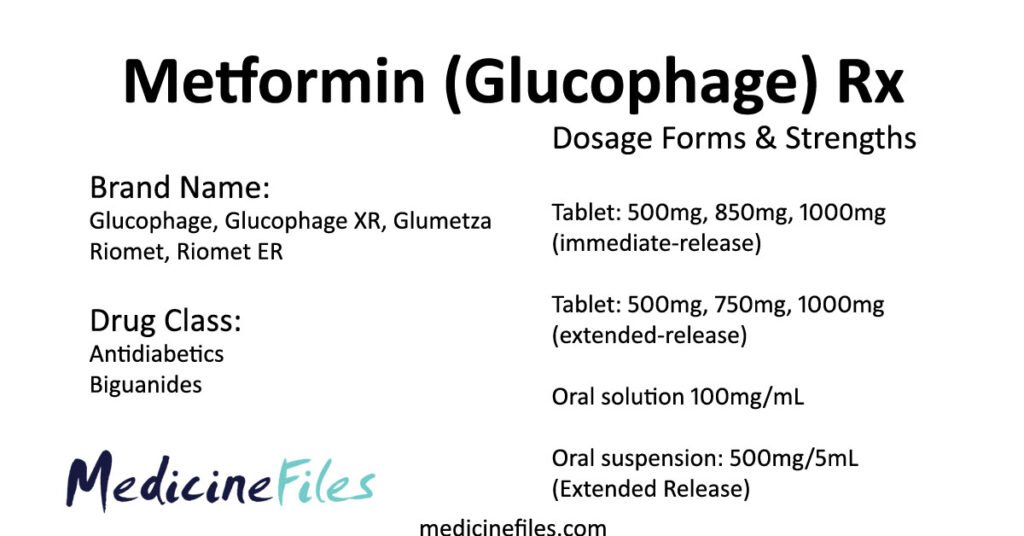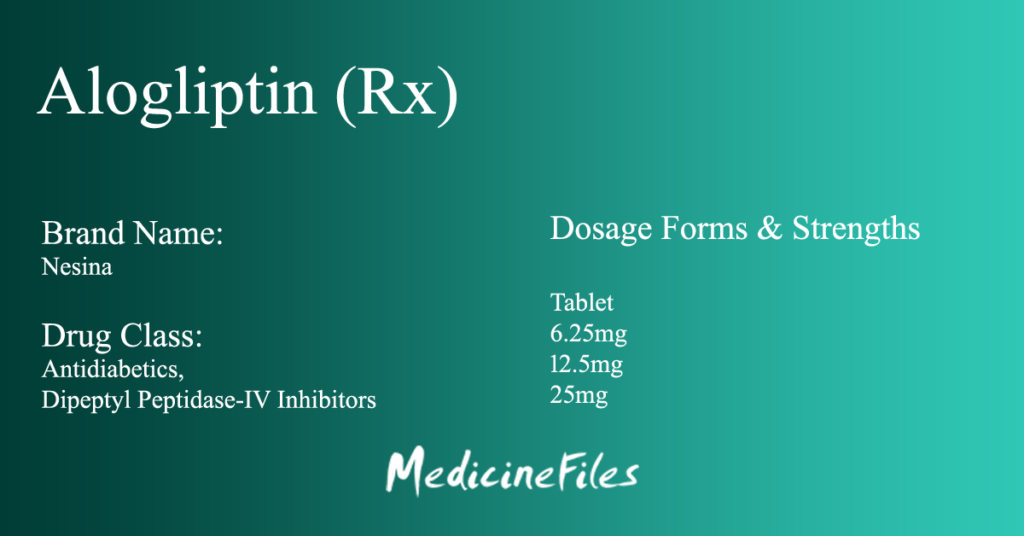Metformin (Rx)
Metformin Brand name: Glucophage, Glucophage XR, Glumetza, Riomet, Riomet ER
Dea Class: Rx (Prescription drug)
Drug Class: Antidiabetics, Biguanides
Dosage form:
Tablet, immediate-release
- 500mg (generic)
- 850mg (generic)
- 1000mg (generic)
Tablet, extended-release
- 500mg (generic, Glumetza)
- 750mg (generic)
- 1000mg (generic, Glumetza)
Oral solution
- 100mg/mL (Riomet)
Oral suspension, extended-release
- 47.31g/473mL per bottle (Riomet ER)
- Reconstituted suspension is 500mg/5mL
What is Metformin and how does it work?
Metformin is oral biguanide antidiabetic agent
It is used for type 2 diabetes mellitus (T2DM) in adult and pediatric patients 10 years and older; first-line T2DM therapy generally includes metformin
Risk of lactic acidosis is low but requires care in prescribing and monitoring
What are Metformin uses?
Adjunctive therapy to diet and exercise to improve glycemic control in adults with type 2 diabetes
Monotherapy or with sulfonylurea
Used for the adjunct treatment of patients with hyperinsulinemia secondary to polycystic ovary syndrome (PCOS), including the treatment of infertility in these patients.
How should I take Metformin?
Metformin comes as a tablet, an extended-release (long-acting) tablet, and a solution (liquid) to take by mouth. The solution is usually taken with meals one or two times a day. The regular tablet is usually taken with meals two or three times a day. The extended-release tablet is usually taken once daily with the evening meal. Take it around the same time(s) every day. Follow the directions on your prescription label carefully, and ask your doctor or pharmacist to explain any part you do not understand. Take it exactly as directed. Do not take more or less of it or take it more often than prescribed by your doctor.
Swallow metformin extended-release tablets whole; do not split, chew, or crush them.
Your doctor may start you on a low dose of drug and gradually increase your dose not more often than once every 1–2 weeks. You will need to monitor your blood sugar carefully so your doctor will be able to tell how well metformin is working.
Metformin controls diabetes but does not cure it. Continue to take metformin even if you feel well. Do not stop taking it without talking to your doctor.
Ask your pharmacist or doctor for a copy of the manufacturer’s information for the patient.
Metformin Side Effects
- Diarrhea, immediate-release product (53%)
- Nausea/vomiting, immediate-release product (25%)
- Diarrhea, extended-release product (10%)
- Nausea/vomiting, extended-release product (7%)
- Low serum vitamin B-12 (7%)
- Abdominal pain (1-5%)
- Constipation (1-5%)
- Abdomen distention (1-5%)
- Dyspepsia/heartburn (1-5%)
- Flatulence (1-5%)
- Dizziness (1-5%)
- Headache (1-5%)
- Upper respiratory infection (1-5%)
- Taste disturbance (1-5%)
- Postmarketing Reports H3
- Cholestatic, hepatocellular, and mixed hepatocellular liver injury
- Lactic acidosis
- Hypoglycemia
What Are Warnings and Precautions for Metformin?
Warnings
Increased risk of severe hypoglycemia especially in older people, debilitated or malnourished, adrenal or pituitary insufficiency, dehydration, heavy alcohol use, hypoxic states, hepatic/renal impairment, stress due to infection, fever, trauma, or surgery
Concomitant administration of insulin and insulin secretagogues (e.g., sulfonylurea) may increase risk of hypoglycemia; therefore, a lower dose of insulin or insulin secretagogue may be required to minimize risk of hypoglycemia when used in combination with metformin
Withholding of food and fluids during surgical or other procedures may increase risk for volume depletion, hypotension, and renal impairment; therapy should be temporarily discontinued while patients have restricted food and fluid intake
Rare lactic acidosis may occur due to metformin accumulation; fatal in approximately 50% of cases; risk increases with age, degree of renal dysfunction, and with unstable or acute CHF; if metformin-associated lactic acidosis suspected, general supportive measures should be instituted promptly in a hospital setting, along with immediate discontinuation of therapy; in patients with a diagnosis or strong suspicion of lactic acidosis, prompt hemodialysis is recommended to correct acidosis and remove accumulated metformin (metformin hydrochloride is dialyzable, with a clearance of up to170 mL/minute under good hemodynamic conditions); hemodialysis has often resulted in reversal of symptoms and recovery
More
Possible increased risk of CV mortality
May cause ovulation in anovulatory and premenopausal PCOS patients
May be necessary to discontinue therapy with metformin and administer insulin if patient is exposed to stress (fever, trauma, infection), or experiences diabetic ketoacidosis
Several of the postmarketing cases of metformin-associated lactic acidosis occurred in setting of acute congestive heart failure (particularly when accompanied by hypoperfusion and hypoxemia); cardiovascular collapse (shock) acute myocardial infarction, sepsis, and other conditions associated with hypoxemia have been associated with lactic acidosis and may also cause prerenal azotemia; discontinue therapy when such events occur
May impair vitamin B12 or calcium intake/absorption; monitor B12 serum concentrations periodically with long-term therapy
Not indicated for use in patients with type 1 diabetes mellitus that are insulin dependent due to lack of efficacy
Withhold in patients with dehydration and/or prerenal azotemia
Conclusive evidence of macrovascular risk reduction with metformin not established
Before taking Metformin, Cautions
- Hypersensitivity to metformin
- CHF
- Diabetic ketoacidosis with or without coma
- Severe renal disease: eGFR <30 mL/min/1.73 m²
- Abnormal creatinine clearance resulting from shock, septicemia, or myocardial infarction
- Lactation
Pregnancy and Lactation
Pregnancy
-
Limited data with in pregnant women are not sufficient to determine drug-associated risk for major birth defects or miscarriage.
Lactation
- Limited published studies report that metformin is present in human milk; however, there is insufficient information to determine effects of metformin on breastfed infant and no available information on effects of metformin on milk production.
What Are Dosages of Metformin?
Dosage Forms & Strengths
2,550 mg/day PO for regular-release tablets and oral solution; 2,000 mg/day PO for extended-release tablets and suspension.
Use more than 1,000 mg/day PO with caution in older adults. Adult Max: 2,550 mg/day PO for regular-release tablets and oral solution; 2,000 mg/day PO for extended-release tablets and suspension.
2,000 mg/day PO for regular-release tablets, oral solution, and extended-release suspension; safe and effective use has not been established for extended-release tablets.
10 years and older: 2,000 mg/day PO for regular-release tablets, oral solution, and extended-release suspension; safe and effective use has not been established for extended-release tablets.
Less than 10 years: Safety and efficacy have not been established.
Safety and efficacy have not been established.
–
Metformin brand name
Brand name: Glucophage, Glucophage XR, Glumetza, Riomet, Riomet ER
Tablet, immediate-release
- 500mg (generic)
- 850mg (generic)
- 1000mg (generic)
Tablet, extended-release
- 500mg (generic, Glumetza)
- 750mg (generic)
- 1000mg (generic, Glumetza)
Oral solution
- 100mg/mL (Riomet)
Oral suspension, extended-release
- 47.31g/473mL per bottle (Riomet ER)
- Reconstituted suspension is 500mg/5mL
Brand names of Metformin combination products
Trijardy® (as a combination product containing Empagliflozin, Linagliptin, Metformin)
Actoplus Met® (containing Metformin, Pioglitazone)
Avandamet® (containing Metformin/Rosiglitazone)
Invokamet® (containing Canagliflozin/Metformin)
Janumet® (containing Metformin/Sitagliptin)
Jentadueto® (containing Linagliptin/Metformin)
Kazano® (containing Alogliptin/Metformin)
Kombiglyze® XR (containing Metformin/Saxagliptin)
Metaglip® (containing Glipizide/Metformin)
Prandimet® (containing Metformin/Repaglinide)
Qternmet® XR (containing Dapagliflozin, Metformin, Saxagliptin),
Segluromet® (containing Ertugliflozin/Metformin)
Synjardy® (containing Empagliflozin/Metformin)
Xigduo® XR (containing Dapagliflozin/Metformin)
Zituvimet® (containing Metformin/Sitagliptin)
Also Read:
Linagliptin Uses, Side Effects, Dosage, Brands


